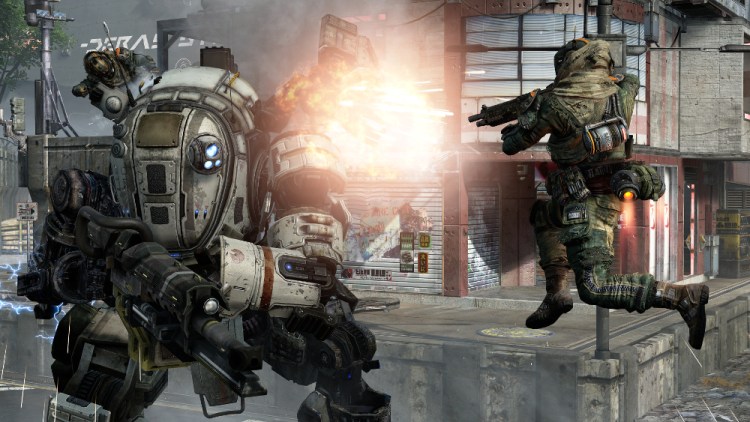When time’s up, and you call for it, boom: Your mech drops from orbit in a sky-rumbling fireball and lands with an earth-shaking thunk — a ground-pound to end all ground-pounds (yes, this will kill any enemies unlucky enough to be standing right underneath). The Titan then sits there silently like a giant statue, hunched over, ready to pick you up and place you into its chest-cavity pilot’s seat. Once you’re in, you quickly light up your internal displays, stand your avatar up, then proceed to destroy with much, much, much more firepower than you were using just moments earlier.
The Titans feel heavy as they lumber down the streets of bases or cities that have turned into battlefields, yet with their own (limited) boost jets, they have a bit of zip to them. You get the exact sense of satisfaction that you’d expect when blasting the now-ant-sized pilots with cannons designed to blow up gigantic metal machines (same with a massive fist punch that instantly pulverizes on-foot enemies into bloody chunks). This is a different feeling of empowerment than what you were getting with the pilots — one that involves actual raw strength and brute force (but strangely, missile blasts and stepping on people both feel a little insubstantial by comparison).
And of course, Titan-on-Titan combat is a quite a sight, with these building-sized monsters bashing each other into scrap metal, especially from the view of a 6-foot-tall pilot. They’re not quite Pacific Rim in terms of sheer size and scale, but it’s all great stuff for a video game.
Yet you never feel invulnerable here, even if other Titans are nowhere to be seen. Pesky pilots are buzzing around — just as easy to squish as a housefly, and just as easy to miss as well. They might be hiding in a building, occasionally poking out a window to fire a homing rocket at you. Or one might be crawling up your back right now to “rodeo” attack you as described earlier (the main counter for which would be for you to exit your own Titan to manually expel unwanted riders).
It’s all a thrill-filled tug of war between the Titans and pilots, with brawn vs. speed, no one side feeling imbalanced or overpowered, and an excellent cadence between playing as the two (after the enemy team destroys your mech, it’s back to being a pilot and waiting for the next Titanfall). The action’s constantly fresh and constantly changing pace — again, making it difficult to go back to “normal,” more flat-footed shooters.
Still more variety
As you progress and reach certain levels or accomplish specific tasks, after matches, Titanfall will reward you with Burn Cards. You can use these “favors” in future battles for a temporary boost — faster movement, upgraded weapons, radar enhancements, the ability to force computer-controlled units to fight for you, shaved seconds off of Titanfall activation, etc. The game is fairly generous with these, and they further mix up the pacing, potentially changing your playstyle even within the same match. For example, you may stay on foot longer and skip out on bringing in a Titan if you’re lugging around an enhanced shotgun. But that “super-nuclear explosion when your Titan dies” Burn Card may encourage you to hide, wait for Titanfall, climb aboard, and then go find a group of unsuspecting Titans to hug.
Accessibility


